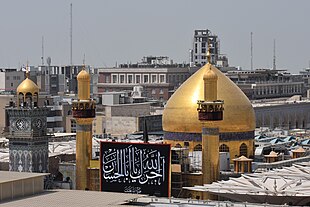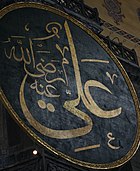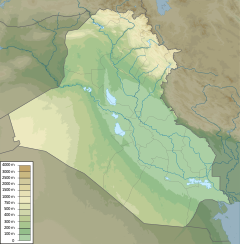
Back Imam-Ali-Moschee (Nadschaf) ALS العتبة العلوية Arabic ضريح الامام على ARZ İmam Əli məscidi Azerbaijani علی بن ابیطالب توربهسی AZB Имам Али мәсете Bashkir ইমাম আলী মসজিদ Bengali/Bangla Mesquita de l'Imam Alí Catalan Alího mešita Czech Imam Ali-moskeen (Najaf) Danish
| Shrine of Imam Ali | |
|---|---|
| |
 Imām 'Alī Shrine, where 'Alī ibn Abī Tālib is believed to be buried | |
| Religion | |
| Affiliation | Islam |
| Province | Najaf Governorate |
| Rite | Muslims |
| Ecclesiastical or organizational status | Mosque and Shrine |
| Status | Active |
| Location | |
| Location | Najaf |
Location in Iraq | |
| Territory | Iraq |
| Geographic coordinates | 31°59′45″N 44°18′53″E / 31.9959°N 44.3146°E |
| Architecture | |
| Architect(s) | Baha' al-din al-'Amili |
| Style | Safavid Persian style |
| Groundbreaking | 1621 CE |
| Completed | 1630 CE |
| Specifications | |
| Dome(s) | 1 |
| Dome height (inner) | 42 metres (138 ft) |
| Minaret(s) | 2 |
| Minaret height | 38 metres (125 ft) |
| Shrine(s) | 1 |
| Website | |
| https://www.imamali.net | |
| Part of a series on |
| Ali |
|---|
 |
The Sanctuary of Imām 'Alī (Arabic: حَرَم ٱلْإِمَام عَلِيّ, romanized: Ḥaram al-ʾImām ʿAlī), also known as the Mosque of 'Alī (Arabic: مَسْجِد عَلِيّ, romanized: Masjid ʿAlī), located in Najaf, Iraq, is a mausoleum which Shia and Sunni Muslims believe contains the tomb of 'Alī ibn Abī Tālib, a cousin, son-in-law and companion of the Islamic Prophet Muhammad. The Shī'as consider 'Alī as their first Imām and the first of the twelve caliphs of Muhammad, and the Sunnis regard him as the fourth Sunni Rashid Caliph.[1] According to Shī'ite belief,[2] buried next to 'Alī within this mosque are the remains of Adam and Nuh (Noah).[2][3] Each year, millions of pilgrims visit the Shrine and pay tribute to Imām 'Alī.
The shrine monument has been built and rebuilt numerous times throughout history;[4] the current shrine dates back to the mid-Safavid period. Its construction began in 1621 under the orders of Shah Abbas the Great and was completed in 1631 after his death. Baha' al-din al-'Amili was appointed as the architect and the structure was designed in the classical Safavid Persian style. Over time the shrine has undergone various notable renovations aimed to enhance its beauty and grandeur, most notably the gilding of the dome and minarets of the shrine in 1743 by Nader Shah Afshar.
- ^ "Ali", Wikipedia, 2021-04-25, retrieved 2021-04-28
- ^ a b al-Qummi, Ja'far ibn Qūlawayh (2008). Kāmil al-Ziyārāt. Shiabooks.ca Press. pp. 66–67.
- ^ Al-Islam.org
- ^ "عمارات المرقد العلوي المطهر". العتبة العلوية المقدسة. Retrieved 2023-11-16.
